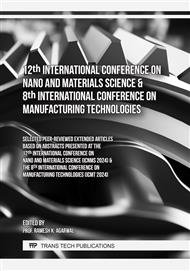p.15
p.33
p.41
p.49
p.59
p.65
p.75
p.81
p.87
Thermoelectric Properties of Spray Coated n-Type PEDOT:PSS Film
Abstract:
Inorganic thermoelectric (TE) materials have gained significant attention because of their salient properties. However, they possess some significant drawbacks, including high production costs, high heat loss, and fragility. Recently, Organic conducting polymers presented a promising platform as an alternative TE material because of their great mechanical flexibility, high stretchability, and environmental friendliness. In this work, we report for the first time on the TE properties of n-PEDOT:PSS film prepared using spray coating technique. The structural, optical and TE properties of the obtained n-PEDOT:PSS thin film was investigated using X-ray diffraction spectroscopy, UV-vis spectroscopy and Seebeck coefficient measurement systems, respectively. The n-PEDOT:PSS layer showed excellent optical properties with a band gap ranges from 3.91 to 3.78. In addition, the Seebeck coefficient and power factor (PF) were obtained to be 1096.77 µVK-1 and 298.59 µWm-1K-2 respectively, making n-PEDOT:P PSS to be regarded as efficient TE material.
Info:
Periodical:
Pages:
59-64
Citation:
Online since:
April 2024
Authors:
Keywords:
Price:
Сopyright:
© 2024 Trans Tech Publications Ltd. All Rights Reserved
Share:
Citation:



